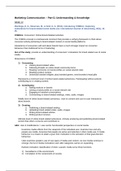Marketing Communication – Part D, Understanding & Knowledge
WEEK 12
Muntinga, D. G., Moorman, M., & Smit, E. G. (2011). Introducing COBRAs: Exploring
motivations for brand-related social media use. International Journal of Advertising, 30(1), 13-
46.
COBRAs: Consumers’ Online Brand-Related activities.
The COBRA concept is a behavioural construct that provides a unifying framework to think about
consumer activity pertaining to brand-related content on social media platforms.
Interactions of consumers with and about brands have a much stronger impact on consumer
behaviour than traditional forms of marketing.
Aim of the study: provide an understanding of consumers’ motivations for brand-related use of social
media.
Dimensions of COBRA:
1) Consuming
a. Viewing brand-related video
b. Following threads on online brand community forms
c. Reading comments on brand profiles on social network sites
d. Reading product reviews
e. Download branded widgets, play branded games, send branded virtual gifts
Represents a minimum level of online brand-related activeness. Participating without actively
contributing to or creating content.
2) Contributing
a. Rating products or brands
b. Joining a brand profile on a social network site
c. Engaging in branded conversations
d. Commenting on brand-related weblogs, video, audio, images
Middle level of online brand-related activeness. User-to-content and user-to-user interactions
about brands.
3) Creating
a. Publishing a brand-related weblog
b. Uploading brand-related video, audio, images
c. Writing brand-related articles
d. Writing product reviews
Ultimate level of online brand-related activeness. Actively producing and publishing brand-related
content that others consume and contribute to.
U&G: User & Gratifications = user-centric functionalist perspective on social media.
Examines media effects from the viewpoint of the individual user. Examine how and why
people use media. Assumes that people are active and selective in their media use. If media
behaviour is a means to attain a goal, then motivation is the activation of that goal-directed
behaviour.
U&G examines people’s use of new types of media and content. As new media continue to
emerge, the list of media motivations and U&G categories carries on expanding.
Earliest motivation classification of U&G: Laswell, media serve three functions.
1) Surveillance of the environment
2) Correlation of the components of society
, 3) Transmission of social heritage
Most cited classification of U&G: McQuail (1983)
Motivations for general social media use, do not address brand-related social media use
1) Entertainment
- Escaping or being diverted from problems or routine
- Emotional release or relief
- Relaxation
- Cultural enjoyment
- Passing time
- Sexual arousal
2) Integration and social interaction
- Sens of belonging
- Connecting with friends, family, society
- Seeking support
- Substituting real-life companionship
3) Personal identity
- Insight into one’s self
- Reinforcing personal values
- Identifying with and gaining recognition from peers
4) Information
- Surveying relevant events in environment
- Seeking advice and opinions
- Risk reduction
5) Remuneration (added later)
- Driver of contributing to online communities because people gain some kind of future
reward (money, job-related, personal wants)
6) Empowerment (added later)
- Exert influence on other people or companies
Research method: unstructured interviewing via IM
Unstructured, open-ended interviews > conversations between peers.
IM: Instant Messaging. Text-based chat software. Encourages people to reveal more personal
information.
Consuming: Driven by three motivations
1) Information
a. Surveillance
i. Up-to-date about social environment
b. Knowledge
i. Learn more about product/ brand
c. Pre-purchase information
i. Reading reviews to make buying decisions
d. Inspiration
i. Getting new ideas
2) Entertainment
a. Enjoyment
b. Relaxation
i. To unwind from everyday life
c. Pastime
i. Browsing a brand profile because you’re bored
3) Remuneration
Contributing: Driven by three motivations
1) Personal identity
a. Self-presentation
i. Providing others with an image of their personality
, b. Self-expression
i. Express and shape one’s identity/ personality
c. Self-assurance
i. Receive other member’s recognition and gain self-assurance
2) Integration
a. Social interaction
i. beMeet like-minded others, interact and talk about brands
b. Social identity
i. Common passion makes people feel a strong connection
c. Helping
i. To help and get help
3) Entertainment
a. Enjoyment
i. Enjoy talking about common interests and sharing brand-related tricks
b. Relaxation
Creating: Driven by four motivations
1) Personal identity
a. Self-presentation
b. Self-expression
i. Brand can be used to express and shape one’s identity
c. Self-assurance
2) Integration and social interaction
a. Social interaction
i. Upload brand content to share information/ receive reactions
b. Social identity
i. Confirming to be part of a group of brand enthusiasts
c. Social pressure
i. Uploading brand content because others do
3) Empowerment
a. People who display their enthusiasm for a brand and enjoy convincing others that the
brand is worth using or purchasing
4) Entertainment
a. Enjoyment
b. Pastime
Voorveld, H. A.M, van Noort, G., Muntinga, D. G., & Bronner, F. (2018). Engagement with social
media and social media advertising: The differentiating role of platform type. Journal of
Advertising, 47(1), 38-54.
Aim: examine the relation between social media engagement and social media advertising.
Engagement experience framework: digital engagement develops from digital experiences and has
3 characteristics:
1) Engagement experience framework fits the media engagement literature, explaining consumer
media interactions, and enables us to advance knowledge on social media engagement.
2) This differs from quantitative approaches about intensity of engagement or valence of
engagement, allowing for context-specific measurement of engagement.
3) Predictive of advertising effectiveness
Engagement: multilevel, multidimensional construct that emerges from the thoughts and feelings
about one or more rich experiences involved in reaching a personal goal.
Engagement is context specific. Context of social media advertising is the social medium platform.
Four categories of social media:
1) Relationship: social media platforms that are profile based and consist mostly of customized
messages; Facebook and LinkedIn
2) Self-media: profile based but offer the chance to manage their own social media
communication channels; Twitter





